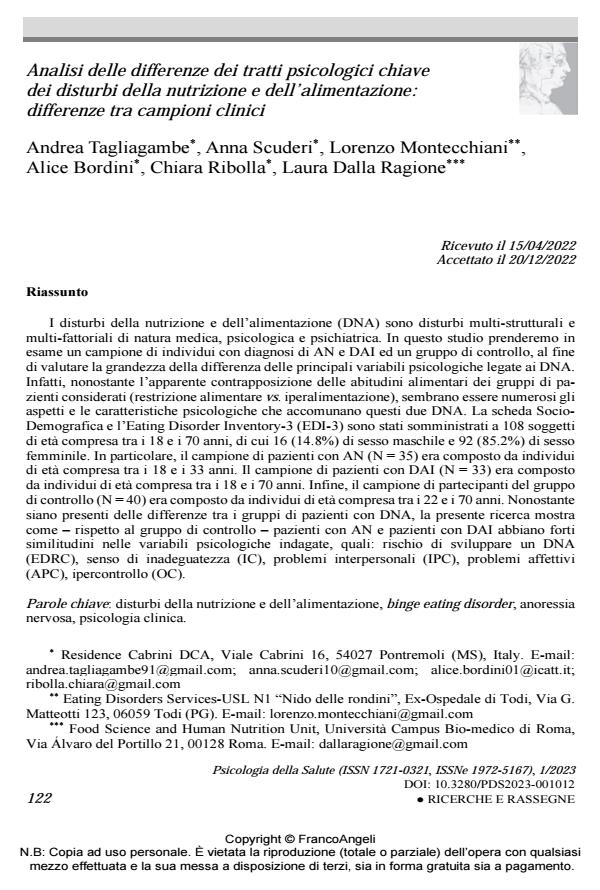Analisi delle differenze dei tratti psicologici chiave dei disturbi della nutrizione e dell’alimentazione: differenze tra campioni clinici
Journal title PSICOLOGIA DELLA SALUTE
Author/s Andrea Tagliagambe, Anna Scuderi, Lorenzo Montecchiani, Alice Bordini, Chiara Ribolla, Laura Dalla Ragione
Publishing Year 2023 Issue 2023/1
Language Italian Pages 17 P. 122-138 File size 256 KB
DOI 10.3280/PDS2023-001012
DOI is like a bar code for intellectual property: to have more infomation
click here
Below, you can see the article first page
If you want to buy this article in PDF format, you can do it, following the instructions to buy download credits

FrancoAngeli is member of Publishers International Linking Association, Inc (PILA), a not-for-profit association which run the CrossRef service enabling links to and from online scholarly content.
Feeding and eating disorders (FEDs) are multi-structural and multi-factorial disorders with a medical, psychological and psychiatric features. In this study we are going to consider a sample composed by a group of individuals diagnosed with AN, a group with a diagnosis of BED and a control group, in order to evaluate the extent of the difference in the main psycho-logical traits related to FEDs. Indeed, despite the groups of patients examined appear to be in contrast in their eating habits (food restriction vs. overeating), numerous psychological aspects and characteristics seem to unite these two FEDs. The Socio-Demographic Schedule and the Eating Disorder Inventory-3 (EDI-3) were administered to 108 subjects aged 18 to 70, whose 16 (14.8%) were male and 92 (85.2%) female. In particular, the sample with AN (N = 35) was composed by individuals aged 18 to 33 years. The sample with BED (N = 33) was com-posed by individuals aged 18 to 70 years. Finally, the control group (N = 40) was composed by individuals aged 22 to 70 years. Although this study confirms the presence of differences between the groups of patients with FEDs, it also shows how ‒ compared to the control group ‒ patients with AN and patients with BED share strong similarities in the psychological traits investigated, such as: risk of developing FED (EDRC), Ineffectiveness Composite (IC), Inter-personal Problems Composite (IPC), Affective Problems Composite (APC), Overcontrol Composite (OC).
Keywords: feeding and eating disorders, binge eating disorder, anorexia nervosa, clinical psy-chology.
Andrea Tagliagambe, Anna Scuderi, Lorenzo Montecchiani, Alice Bordini, Chiara Ribolla, Laura Dalla Ragione, Analisi delle differenze dei tratti psicologici chiave dei disturbi della nutrizione e dell’alimentazione: differenze tra campioni clinici in "PSICOLOGIA DELLA SALUTE" 1/2023, pp 122-138, DOI: 10.3280/PDS2023-001012